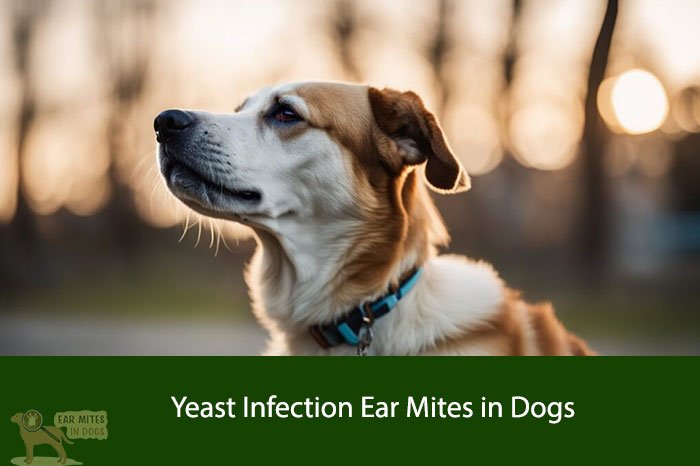Yeast infection ear mites in dogs is a common problem that many pet owners face. Ear mites are tiny parasites that live in the ear canal and feed on the wax and oils in the ear. They can cause irritation and inflammation, which can lead to a secondary yeast infection. Yeast infections can be very uncomfortable for dogs and can cause a lot of pain and itching.
Symptoms of yeast infection ear mites in dogs include shaking of the head, scratching at the ears, and a foul odor coming from the ears. If left untreated, the infection can spread to other parts of the body and cause serious health problems. It is important to seek veterinary care if you suspect your dog has a yeast infection or ear mites.
Treatment for yeast infection ear mites in dogs typically involves medication to kill the mites and antibiotics to treat the yeast infection. It is important to follow your veterinarian’s instructions carefully and complete the full course of treatment to ensure that the infection is fully eradicated. With proper treatment, most dogs make a full recovery and are able to live happy, healthy lives.
Understanding Yeast Infections and Ear Mites in Dogs

Yeast infections and ear mites are common problems that dogs face. Yeast infections occur when there is an overgrowth of yeast in the ear canal, while ear mites are tiny parasites that live in the ear canal. Both conditions can cause discomfort and irritation for your furry friend.
Symptoms of Yeast Infections and Ear Mites
Some common symptoms of yeast infections in dogs include:
- Redness and inflammation of the ear canal
- Itching and scratching at the ear
- A strong, unpleasant odor coming from the ear
- Discharge or crusty buildup in the ear
Symptoms of ear mites in dogs include:
- Itching and scratching at the ear
- Head shaking or tilting
- Dark, crumbly discharge from the ear
- Redness and inflammation of the ear canal
Treatment Options
If you suspect that your dog has a yeast infection or ear mites, it’s important to take them to the vet for a proper diagnosis. Your vet may prescribe medication to treat the infection or mites. In addition to medication, there are some home remedies you can try to help alleviate your dog’s symptoms.
For yeast infections, you can try cleaning your dog’s ears with a mixture of water and apple cider vinegar. This can help to restore the pH balance in the ear and reduce the growth of yeast. You can also try adding probiotics to your dog’s diet to promote healthy gut bacteria, which can help to prevent yeast infections.
For ear mites, you can try cleaning your dog’s ears with a mixture of water and hydrogen peroxide. This can help to kill the mites and reduce inflammation. You can also try adding coconut oil to your dog’s diet, as it has natural anti-inflammatory properties that can help to soothe the ear canal.
In conclusion, yeast infections and ear mites can be uncomfortable for your dog, but they can be treated with medication and home remedies. If you suspect that your dog has either of these conditions, it’s important to take them to the vet for a proper diagnosis and treatment plan.
Causes of Yeast Infections in Dogs

Yeast infections in dogs are caused by an overgrowth of the fungi that naturally live in the body. While yeast is present in all dogs, certain factors can cause it to grow out of control, leading to an infection. In this section, we will discuss some of the most common causes of yeast infections in dogs.
Immune System Disorders
Dogs with weakened immune systems are more susceptible to yeast infections. This can be due to a variety of factors, including genetic predisposition, chronic illness, or stress. When the immune system is compromised, it is less able to fight off the overgrowth of yeast, allowing it to thrive and cause an infection.
Warm and Humid Environments
Yeast thrives in warm and humid environments, making dogs that live in these conditions more prone to infections. This can be especially true for dogs with long, floppy ears that trap moisture and create the perfect environment for yeast to grow. Dogs that spend a lot of time in water or wet environments, such as swimmers or those who live in rainy climates, are also at increased risk.
Antibiotic Use
Antibiotics are designed to kill harmful bacteria, but they can also kill off the beneficial bacteria that keep yeast in check. When this happens, yeast can grow out of control and cause an infection. Dogs that are on long-term antibiotic treatment or have frequent antibiotic use are at increased risk of developing yeast infections.
By understanding the common causes of yeast infections in dogs, we can take steps to prevent them from occurring. Regular grooming, keeping ears clean and dry, and avoiding unnecessary antibiotic use are all important steps in maintaining a healthy balance of yeast in our furry friends.
Causes of Ear Mites in Dogs

Ear mites are a common problem in dogs and can cause discomfort and irritation. There are several factors that can contribute to the development of ear mites in dogs.
Close Contact with Infected Animals
One of the primary causes of ear mites in dogs is close contact with infected animals. Ear mites are highly contagious and can easily spread from one animal to another through direct contact. Dogs that spend time with other animals, such as at dog parks or kennels, are at a higher risk of contracting ear mites.
Environmental Factors
Environmental factors can also play a role in the development of ear mites in dogs. Dogs that live in warm, humid environments are more susceptible to ear mites, as the mites thrive in these conditions. Additionally, dogs that have poor hygiene or live in unsanitary conditions are more likely to develop ear mites.
To prevent ear mites in dogs, it is important to maintain proper hygiene and keep the dog’s environment clean. Regular grooming and cleaning of the ears can also help prevent the development of ear mites. If you suspect that your dog has ear mites, it is important to seek veterinary care to properly diagnose and treat the condition.
Symptoms of Yeast Infections in Dogs

Yeast infections in dogs can cause a variety of symptoms. In this section, we will discuss some of the most common symptoms of yeast infections in dogs.
Ear Irritation and Discharge
One of the most common symptoms of a yeast infection in a dog is ear irritation and discharge. Dogs with yeast infections may shake their heads or scratch their ears frequently. The ears may appear red and inflamed, and there may be a foul-smelling discharge.
Changes in Skin and Coat
Yeast infections can also cause changes in a dog’s skin and coat. Dogs with yeast infections may develop dry, flaky skin or oily, greasy skin. The skin may appear red and irritated, and there may be hair loss or bald patches. The coat may also appear dull and lackluster.
Odor and Itching
Another common symptom of a yeast infection in dogs is odor and itching. Dogs with yeast infections may have a strong, musty odor. They may also scratch and lick themselves excessively, which can lead to further irritation and infection.
Overall, if you notice any of these symptoms in your dog, it is important to consult with your veterinarian. Yeast infections can be uncomfortable and even painful for dogs, and prompt treatment is essential to prevent further complications.
Symptoms of Ear Mites in Dogs
Ear mites are a common problem for dogs, and they can cause a range of symptoms. If you suspect your dog has ear mites, it’s important to take them to the vet for treatment. Here are some of the most common symptoms of ear mites in dogs:
Excessive Scratching
One of the most obvious signs of ear mites in dogs is excessive scratching. If your dog is constantly scratching at their ears or shaking their head, it could be a sign that they have ear mites. Ear mites can cause intense itching and irritation, which can lead to your dog scratching their ears until they bleed.
Head Shaking
Another common symptom of ear mites in dogs is head shaking. If your dog is shaking their head frequently, it could be a sign that they have ear mites. Ear mites can cause discomfort and irritation in the ears, which can lead to your dog shaking their head in an attempt to relieve the discomfort.
Dark, Waxy Ear Discharge
Ear mites can also cause a dark, waxy discharge in your dog’s ears. This discharge may have a foul odor and can be a sign of an ear infection. If you notice this discharge in your dog’s ears, it’s important to take them to the vet for treatment.
In conclusion, if you notice any of these symptoms in your dog, it’s important to take them to the vet for treatment. Ear mites can be uncomfortable and even painful for your dog, so it’s important to get them treated as soon as possible.
Diagnosis of Yeast Infections and Ear Mites

When a dog shows signs of ear discomfort or infection, it is important to diagnose the underlying cause. Yeast infections and ear mites are two common culprits that can cause similar symptoms. In order to determine the cause of the problem, a thorough diagnostic evaluation is necessary.
Physical Examination
During a physical examination, we will inspect the dog’s ears for signs of redness, swelling, discharge, or odor. We will also look for evidence of ear mites, such as black debris or crusts in the ear canal. If the dog is in pain, we may need to sedate them in order to perform a complete examination.
Microscopic Evaluation
A microscopic evaluation of a sample of ear discharge can help us determine if yeast or bacteria are present. We will use a special stain to identify the type of organism causing the infection. If ear mites are suspected, a sample of debris from the ear canal can be examined under the microscope to confirm the presence of mites.
Culture and Sensitivity Tests
In some cases, a culture and sensitivity test may be necessary to identify the specific type of bacteria causing the infection. This test involves taking a sample of ear discharge and growing it in a laboratory to identify the type of bacteria present. Once the bacteria have been identified, we can determine which antibiotics will be most effective in treating the infection.
In summary, a thorough diagnostic evaluation is necessary to determine the cause of ear discomfort or infection in dogs. A physical examination, microscopic evaluation, and culture and sensitivity tests may all be necessary to identify the underlying cause of the problem. With an accurate diagnosis, we can provide effective treatment and help prevent future ear problems.
Treatment Options for Yeast Infections
Yeast infections in dogs can be treated with a variety of options, depending on the severity of the infection. In this section, we will discuss the most common treatment options for yeast infections in dogs.
Topical Therapies
Topical therapies are often used to treat mild yeast infections in dogs. These therapies include medicated shampoos, ear cleaners, and ointments. Medicated shampoos containing antifungal agents can help to reduce yeast growth on the skin. Ear cleaners can be used to clean the ears and remove excess wax and debris, which can contribute to yeast overgrowth. Ointments containing antifungal agents can be applied to affected areas to help reduce yeast growth.
Oral Medications
Oral medications may be necessary for more severe yeast infections in dogs. These medications include antifungal drugs, such as ketoconazole, fluconazole, and itraconazole. These drugs work by inhibiting the growth of yeast. It is important to follow the dosage instructions provided by your veterinarian and to complete the entire course of treatment.
Lifestyle and Diet Changes
Lifestyle and diet changes can also be effective in treating yeast infections in dogs. A healthy diet can help to boost the immune system and reduce the risk of yeast overgrowth. Foods that are high in carbohydrates, such as grains and potatoes, should be avoided. Instead, a diet that is high in protein and low in carbohydrates is recommended. Regular exercise can also help to boost the immune system and reduce the risk of yeast overgrowth.
In conclusion, there are several treatment options available for yeast infections in dogs. Topical therapies, oral medications, and lifestyle and diet changes can all be effective in treating yeast infections. It is important to work closely with your veterinarian to determine the best treatment plan for your dog.
Treatment Options for Ear Mites
Ear mites can be a frustrating and uncomfortable condition for dogs. Fortunately, there are several treatment options available to help alleviate the symptoms and eliminate the mites. In this section, we will discuss the most common treatment options for ear mites in dogs.
Medicated Ear Drops
Medicated ear drops are one of the most common treatments for ear mites in dogs. These drops contain medication that helps to kill the mites and soothe the irritated skin in the ear canal. It is important to follow the instructions provided by your veterinarian when administering these drops, as overuse or misuse can lead to further complications.
Anti-Parasitic Medications
In some cases, oral medication may be prescribed to help eliminate the ear mites. These medications are typically anti-parasitic and work by killing the mites from the inside out. Your veterinarian may also recommend additional medication to help alleviate any discomfort or inflammation caused by the mites.
Environmental Cleaning
In addition to medication, it is important to thoroughly clean your dog’s environment to prevent a re-infestation of ear mites. This includes washing bedding, vacuuming carpets and upholstery, and cleaning any surfaces that your dog may come into contact with. Your veterinarian may also recommend a special ear cleaning solution to help remove any debris or mites from your dog’s ears.
In conclusion, ear mites can be a bothersome condition for dogs, but with the right treatment, they can be eliminated. Medicated ear drops, anti-parasitic medications, and environmental cleaning are all effective treatment options for ear mites in dogs. If you suspect that your dog may have ear mites, it is important to consult with your veterinarian for proper diagnosis and treatment.
Prevention Strategies for Yeast Infections and Ear Mites
When it comes to preventing yeast infections and ear mites in dogs, taking proactive measures is key. Here are some effective strategies to consider:
Regular Ear Cleaning
Cleaning your dog’s ears regularly is an important part of preventing yeast infections and ear mites. Use a gentle ear cleaning solution and cotton balls or gauze to wipe the inside of your dog’s ears. Avoid using cotton swabs as they can push debris further into the ear canal and potentially damage the eardrum.
Proper Grooming Practices
Proper grooming practices can also help prevent yeast infections and ear mites. Regular brushing and bathing can help keep your dog’s coat clean and free of debris. Be sure to dry your dog’s ears thoroughly after bathing or swimming to prevent moisture from building up in the ear canal.
Environmental Control
Environmental factors can also contribute to the development of yeast infections and ear mites. Keep your dog’s living area clean and free of excess moisture. Consider using a dehumidifier to reduce humidity levels in your home. Avoid exposing your dog to potential allergens and irritants, such as cigarette smoke, pollen, and certain cleaning products.
By following these prevention strategies, we can help keep our furry friends healthy and free of yeast infections and ear mites.
Monitoring and Long-Term Management

After treating a dog for yeast infection ear mites, it is important to monitor them closely to ensure that the infection does not return. Here are some key steps to follow:
Follow-Up Vet Visits
We recommend scheduling a follow-up visit with your veterinarian a few weeks after treatment to check for any signs of recurrence. During this visit, the vet will examine your dog’s ears and may take a sample of ear wax to check for the presence of yeast or bacteria.
If the infection has not cleared up completely, your vet may recommend additional treatment or a change in medication. It is important to follow their instructions carefully to ensure that the infection is fully resolved.
Ongoing Preventative Care
To prevent future yeast infection ear mites, we recommend taking the following steps:
- Regular ear cleaning: Clean your dog’s ears regularly to remove excess wax and debris. Use a gentle, pet-safe ear cleaner and follow the instructions carefully.
- Avoid moisture: Keep your dog’s ears as dry as possible. After swimming or bathing, dry their ears thoroughly with a towel.
- Monitor for symptoms: Keep an eye out for any signs of ear infection, such as itching, redness, or discharge. If you notice any of these symptoms, contact your vet right away.
By following these steps, you can help prevent future ear infections and keep your dog healthy and comfortable. If you have any questions or concerns, don’t hesitate to contact your veterinarian for advice.
Frequently Asked Questions
What are the signs and symptoms of a yeast infection in a dog’s ear?
Some common signs of a yeast infection in a dog’s ear include redness, inflammation, bad odor, discharge, and itching. Your dog may also shake their head or scratch their ear frequently.
What home remedies are effective for treating a dog’s ear yeast infection?
There are several home remedies that can help treat a dog’s ear yeast infection, such as cleaning the ear with a mixture of water and vinegar, applying coconut oil or tea tree oil, and giving your dog probiotics. However, it’s important to consult with your veterinarian before trying any home remedies.
How can ear mites be identified and distinguished from yeast infections in dogs?
Ear mites in dogs can be identified by their microscopic appearance and behavior, such as scratching their ears excessively and shaking their head. Yeast infections, on the other hand, are usually diagnosed through a physical examination by a veterinarian.
What are the best methods for treating ear mites in dogs at home?
Some effective methods for treating ear mites in dogs at home include cleaning the ear with a mixture of water and vinegar, applying mineral oil, and giving your dog flea and tick medication. However, it’s important to consult with your veterinarian before trying any home remedies.
What are the potential consequences of an untreated yeast infection in a dog’s ear?
If left untreated, a yeast infection in a dog’s ear can lead to more serious health problems, such as chronic ear infections, hearing loss, and even facial paralysis.
How do dogs typically contract ear mites?
Dogs typically contract ear mites through close contact with other infected animals or contaminated objects. They can also be picked up from the environment, such as grass and soil.





